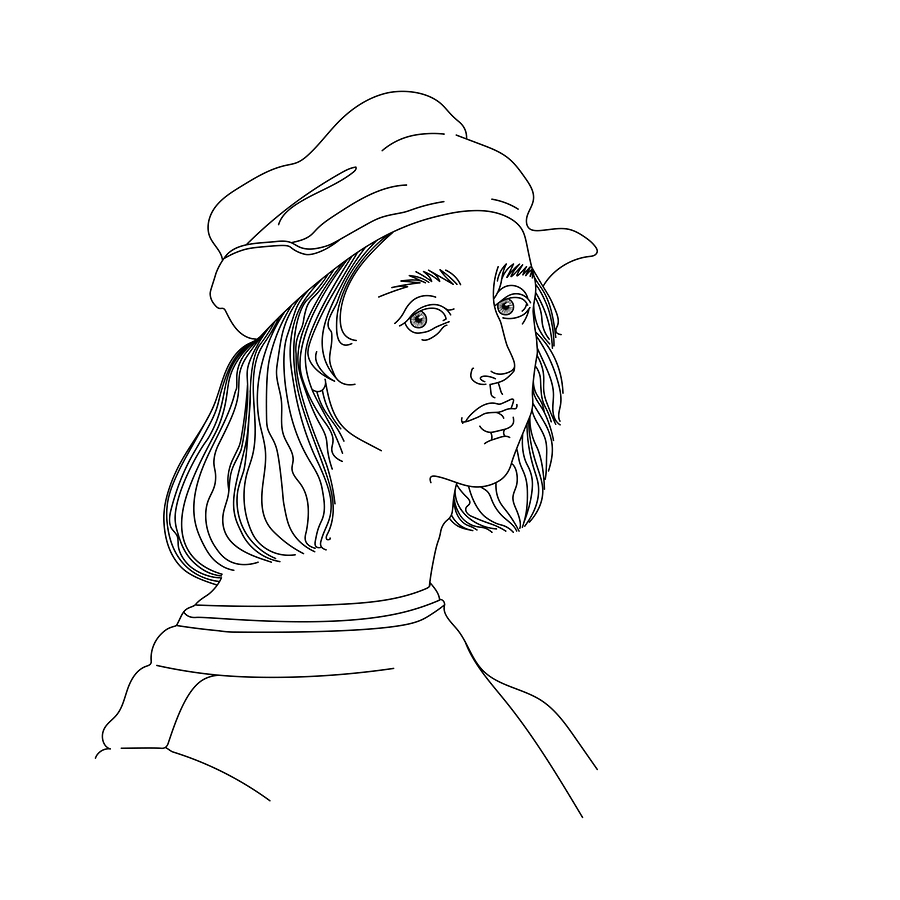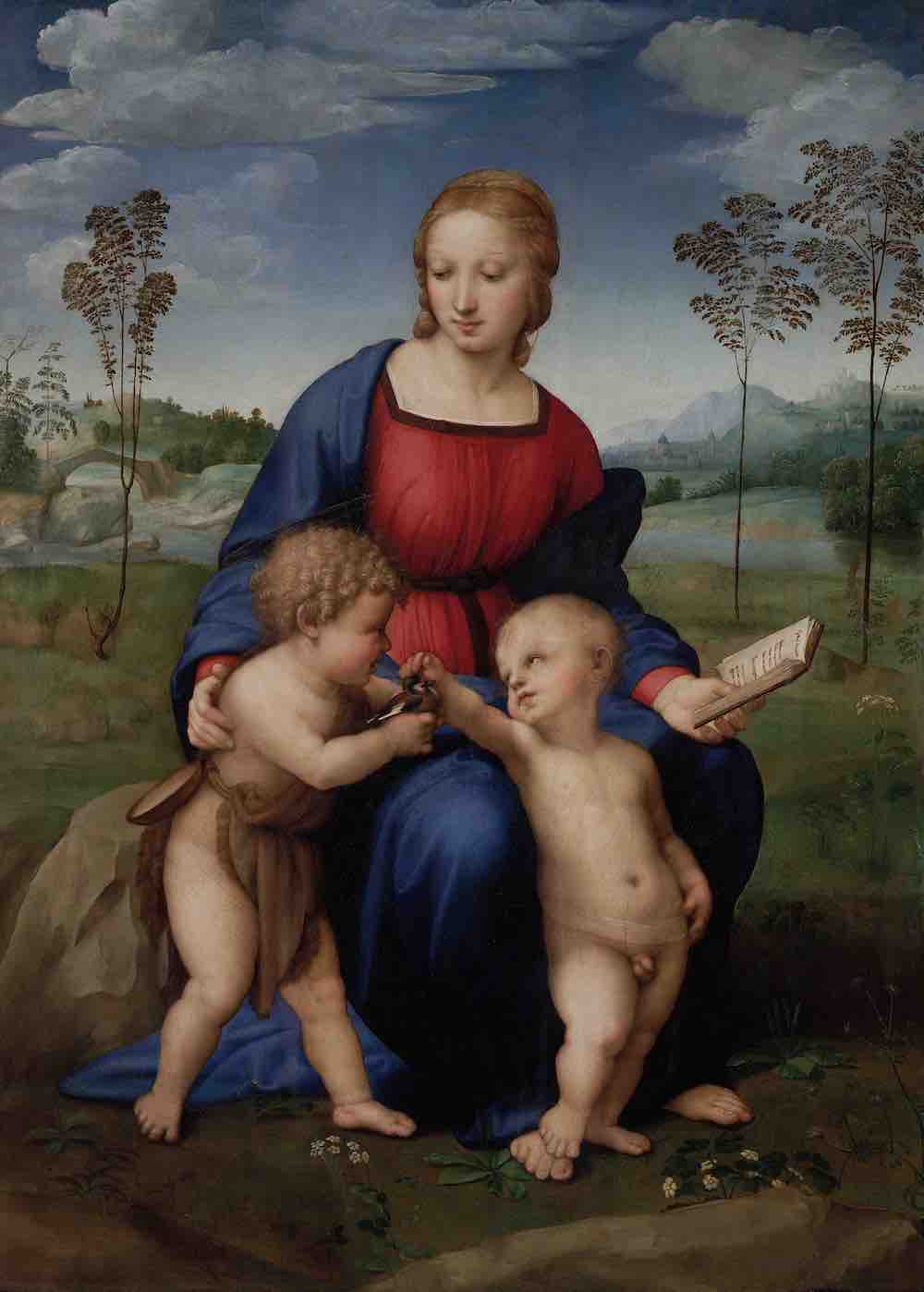In the fall of 1504, 21-year-old Raffaello Sanzio mounted a mule and began winding his way down the mountainous pathsfrom Urbino. At first glance, leaving his birthplace might have seemed a stupid decision for the young artist. After all, the orphaned Raphael had inherited his father’s successful painting studio and a gracious home on a steep street in the center of town. He had also taken over his father’s role as a court painter in the service of the duke and duchess of Urbino.
In the comfortable embrace of the ducal court, Raphael enjoyed a stipend, a regular string of painting commissions, and the favor of powerful patrons. Why would he leave behind such an enviable position?
The answer is simple: In 1504, Florence was the place to be. Much like an ambitious musical theater student today might yearn to “make it big” in New York City, at the turn of the sixteenth century, Florence held an inexorable pull for any artist who wanted to make a mark on the world.

Although many of the celebrations of the artist’s life in 2020—the 500th anniversary of Raphael’s death—have been altered or cancelled because of the worldwide pandemic, we can still appreciate Raphael’s contribution to the history of art and especially his stamp on the city of Florence.
AN UNPRECEDENTED MOMENT IN ART HISTORY
When Raphael arrived in Florence, Michelangelo’s trailblazing statue of David had just been erected in the Piazza della Signoria. The paint on Leonardo da Vinci’s latest portrait (a depiction of a certain Lisa, wife of a wealthy wool merchant) was still wet. Florentine authorities had just coerced the two artists into a public competition for new wall paintings inside the Palazzo Vecchio. And in addition to Da Vinci and Michelangelo, the streets of Florence teemed with the likes of Sandro Botticelli, Andrea della Robbia, Piero di Cosimo, Davide Ghirlandaio, Simone del Pollaiuolo, Antonio and Giuliano da Sangallo, Andrea Sansovino, Pietro Perugino, Filippino Lippi, and many others now considered towering giants of the Italian Renaissance. What ambitious artist wouldn’t want to jump head-first into this creative stew?
Raphael was fortunate enough to arrive in Florence with a few connections. He may have had a letter of introduction in hand from his influential patrons in Urbino, and Raphael’s teacher, Perugino, may have helped the budding artist with early commissions in the city. He began work on two large altarpieces for Perugian clients—the so-called Ansidei Madonna and the Baglioni Altarpiece. He also made another altarpiece for a chapel inside Santo Spirito.

In the surviving drawings from Raphael’s Florentine period (1504-1508), we see quick sketches of Michelangelo’s David, and his attempts to replicate hands, faces, drapery, and other details from the work of these more acknowledged giants of Florentine art. Raphael was learning—and watching carefully. At the same time, he was developing his own refined style. In just a few years, his hard work paid off; Pope Julius II lured Raphael to Rome in 1508.
WHERE TO SEE RAPHAEL’S WORK IN FLORENCE
Today, many of Raphael’s most iconic works remain in Rome, where Raphael ultimately settled before his unfortunate death at 37 years old. However, in Florence, it’s easy to appreciate Raphael’s incredible technical ability and distinctive vision—a style arguably more synonymous with the High Renaissance than that of any other artist. And in Florence, we can perceive the mind of a young, ambitious painter who was about to give Michelangelo and Da Vinci a run for their money.
AT THE UFFIZI GALLERIES
Piazzale degli Uffizi, 6; web site
The Uffizi recently reorganized its Renaissance galleries and now features a room highlighting the interactions of Raphael, Michelangelo, and their contemporaries in the first decade of the 16th century. This fascinating arrangement helps visitors understand the artistic relationships between these infamous artists who, remarkably, lived at the same time and in the same place.
Self-Portrait, oil on panel, 1504-1506
This small picture has long been presumed as a self-portrait of the young artist, and it gives us an impression of Raphael as he left Urbino for the glamor and promise of Florence in 1504.

Portraits of Maddalena Strozzi and Agnolo Doni, oil on panel, 1504-1507
The Doni family provided Raphael with his first major portrait commission in Florence. The recently married couple were well-connected in Florence and probably introduced Raphael to their friends. One fascinating feature of these portraits is that they were likely hinged together and meant to be seen from the back as well as from the front. Mythological scenes in muted, neutral tones were painted on the backs by another, unnamed artist known only as the Master of Serumido. During the time Raphael painted this portrait pair, Michelangelo painted a large circular painting (a tondo) for the Doni, perhaps in celebration of the birth of long-wished-for child. The Doni Tondo now stands in the same gallery as these portraits.

Madonna of the Goldfinch, oil on panel, 1504-1506
Madonnas were Raphael’s bread and butter throughout his career. They sold like hotcakes, and Raphael customized each image of the Virgin and Child for his patrons. This one was painted for Raphael’s patron and friend Lorenzo Nasi, perhaps on the occasion of Nasi’s marriage. According to contemporary sources, this picture was nearly destroyed by an earthquake in 1548, but was pieced back together at the time. Between 2002 and 2008, the painting underwent a major restoration.

Earlier and later works by Raphael housed in the Uffizi:
• Portraits of Elisabetta Gonzaga and Guidobaldo da Montefeltro, circa 1504: These interesting portraits depict the Duke and Duchess of Urbino, who were probably sad to see their court painter, Raphael, leave town for better prospects in Florence and Rome.
• Portrait of a Young Man with an Apple, circa 1504: This is possibly Francesco Maria I della Rovere, who was the adopted son of Elisabetta and Guidobaldo (above), as well as their heir to the Duchy of Urbino.
• Portrait of Julius II, 1511-1512: There are several versions of this portrait of Raphael’s patron in Rome; Julius commissioned Raphael to paint The School of Athens and other major works in the papal palace.
• Pope Leo X with Cardinals Giulio de Medici and Luigi de Rossi, 1518: Pope Leo X was the son of Lorenzo de Medici, and for Raphael, this picture connected the disparate worlds of Florentine and Roman power.
IN THE PALATINE GALLERY AT THE PITTI PALACE
Piazza de Pitti, 1; website
Madonna of the Grand Duke (Madonna del Granduca), oil on wood, 1505
Undoubtedly, Raphael encountered Leonardo da Vinci’s work in Florence. This Madonna shows the influence of Leonardo in its use of sfumato, or smoke-like, softened outlines. The name of this picture derives from Ferdinand III, Grand Duke of Tuscany, who once kept it in his collection.

Portrait of a Pregnant Woman (La Donna Gravida), oil on panel, 1505-1506
I find this one of Raphael’s most fascinating works, mostly because of its ambiguity. Pregnant women were rare subjects in Italian Renaissance art. We do not know the identity of the sitter, a rather glum-looking woman with a hand on her swelling mid-section. Raphael has depicted the woman in noble clothing, but there is something about her that—like Raphael’s later portraits of Margherita Luti—gives the impression Raphael might have been inspired not by a noble lady, but perhaps by a fruit seller or fish monger he encountered in a Florentine market.
Raphael Donna Gravida. Photo credit: Public Domain " data-entity-type="file" data-entity-uuid="65407e4b-e69f-4e61-acc3-1b51a4f7f29c" data-responsive-image-style="inline_image" data-cke-saved-src="/sites/default/files/inline-images/Raphael%20Donna%20Gravida.jpg" src="/sites/default/files/inline-images/Raphael%20Donna%20Gravida.jpg">
Madonna del Baldacchino, oil on canvas, 1507-1508
This picture was Raphael’s first major commission in Florence, made for the Dei chapel in the church of Santo Spirito. The image reprises the popular theme of the sacra conversazione, or “sacred conversation” among saints and the Madonna. When Pope Julius II summoned Raphael to Rome in 1508, this picture remained behind, unfinished.
Later works by Raphael housed at the Palazzo Pitti:
• Woman with a Veil (Donna Velata), 1512-1515: This portrait was made in Rome. Raphael’s lover, Margherita Luti (the so-called fornarina or baker’s daughter) probably served as the model.
• Madonna dell’Impannata, 1513-1514: Many art historians consider this picture executed primarily by Raphael’s assistants.
• Madonna della Seggiola, 1514: This beautiful tondo seems to sum up all the perfection of the Italian Renaissance and has inspired generations of artists.
• Portrait of Tommaso Inghirami, 1516: Inghirami was a scholar, writer, and actor who encountered Raphael in the pope’s circle. Inghirami suffered from a condition that prevents the eyes from aligning, which Raphael captures in this lively portrait.
• Portrait of Cardinal Bibbiena, 1516: Pope Leo’s private secretary and a well-connected friend of Raphael’s in Rome, Bibbiena was also a literary and comedy writer.
• Vision of Ezekiel, 1518: The Renaissance art historian Giorgio Vasari recorded that Vincenzo Ercolani, a Bolognese nobleman, commissioned Raphael to paint this subject. In style, it shows the influence of Michelangelo’s Sistine Chapel ceiling, with which Raphael was undoubtedly familiar.
Laura Morelli is an art historian and historical novelist with a passion for Italy. You can find much more about what to bring home from Italy in her guidebook series, including Made in Florence and Made in Italy. These books, along with Laura’s Venice-inspired historical novels, including The Gondola Maker, are available in the Italy Magazine shop.





